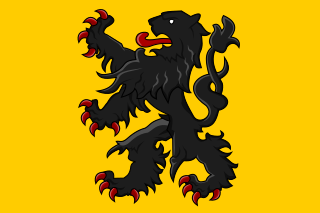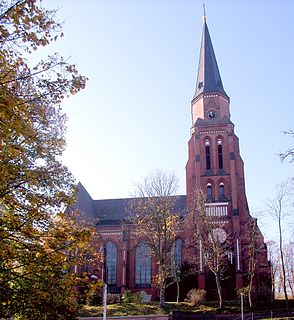Related Research Articles

Adam of Bremen was a German medieval chronicler. He lived and worked in the second half of the eleventh century. Adam is most famous for his chronicle Gesta Hammaburgensis ecclesiae pontificum. He was "one of the foremost historians and early ethnographers of the medieval period".

1066 (MLXVI) was a common year starting on Sunday of the Julian calendar.

Year in topic Year 1015 (MXV) was a common year starting on Saturday of the Julian calendar.

Meissen is a town of approximately 30,000 about 25 km (16 mi) northwest of Dresden on both banks of the Elbe river in the Free State of Saxony, in eastern Germany. Meissen is the home of Meissen porcelain, the Albrechtsburg castle, the Gothic Meissen Cathedral and the Meissen Frauenkirche. The Große Kreisstadt is the capital of the Meissen district.

The Battle of Hastings was fought on 14 October 1066 between the Norman-French army of William, the Duke of Normandy, and an English army under the Anglo-Saxon King Harold Godwinson, beginning the Norman conquest of England. It took place approximately 7 mi (11 km) northwest of Hastings, close to the present-day town of Battle, East Sussex, and was a decisive Norman victory.
Meissen is a district (Kreis) in the Free State of Saxony, Germany. It is bounded by the state of Brandenburg, the district of Bautzen, the urban district Dresden, the districts Sächsische Schweiz-Osterzgebirge, Mittelsachsen and Nordsachsen.

The House of Wettin is a dynasty of German counts, dukes, prince-electors and kings that once ruled territories in the present-day German states of Saxony, Saxony-Anhalt and Thuringia. The dynasty is one of the oldest in Europe, and its origins can be traced back to the town of Wettin, Saxony-Anhalt. The Wettins gradually rose to power within the Holy Roman Empire. Members of the family became the rulers of several medieval states, starting with the Saxon Eastern March in 1030. Other states they gained were Meissen in 1089, Thuringia in 1263, and Saxony in 1423. These areas cover large parts of Central Germany as a cultural area of Germany.

Ernest was Elector of Saxony from 1464 to 1486.

Meissen porcelain or Meissen china was the first European hard-paste porcelain. Early experiments were done in 1708 by Ehrenfried Walther von Tschirnhaus. After his death that October, Johann Friedrich Böttger continued von Tschirnhaus's work and brought this type of porcelain to the market, financed by Augustus the Strong, King of Poland and Elector of Saxony. The production of porcelain in the royal factory at Meissen, near Dresden, started in 1710 and attracted artists and artisans to establish, arguably, the most famous porcelain manufacturer known throughout the world. Its signature logo, the crossed swords, was introduced in 1720 to protect its production; the mark of the swords is reportedly one of the oldest trademarks in existence. Dresden porcelain was once the usual term for these wares, until the Oberlandesgericht decided in favour of the Saxon Porcelain Manufactory Dresden, which alone was then allowed to use the name Dresden Porcelain.

Frederick II, The Gentle was Elector of Saxony (1428–1464) and was Landgrave of Thuringia (1440–1445).

Benno was named Bishop of Meissen in 1066. Venerated since the 13th century, he was canonized in 1523. Benno did much for his diocese, both by ecclesiastical reforms on the Hildebrandine model and by material developments. He was venerated in his native Saxony throughout the Late Middle Ages.

The Margravate of Meissen was a medieval principality in the area of the modern German state of Saxony. It originally was a frontier march of the Holy Roman Empire, created out of the vast Marca Geronis in 965. Under the rule of the Wettin dynasty, the margravate finally merged with the former Duchy of Saxe-Wittenberg into the Saxon Electorate by 1423.
Gertrud of Brunswick was Countess of Katlenburg by marriage to Dietrich II, Count of Katlenburg, Margravine of Frisia by marriage to Henry, Margrave of Frisia, and Margravine of Meissen by marriage to margrave Henry I.

The Diocese of Dresden–Meissen is a Diocese of Catholic Church in Germany with its seat in Dresden. It is suffragan to the Archdiocese of Berlin.
Otto I was the Margrave of Meissen from 1062 until his death in 1067, and the second Margrave of the family of the counts of Weimar and Orlamünde. He was a younger son of William III of Weimar and Oda, daughter of Thietmar, Margrave of the Saxon Ostmark. He inherited Orlamünde from his father in 1039 and Weimar from his brother William in 1062. He was appointed by the Emperor Henry IV to succeed William in Meissen as well. He became Advocate of the Cathedral of Merseburg in 1066.

The Diocese of Görlitz is a diocese of the Roman Catholic church in Germany. The current ordinary is Wolfgang Ipolt
The German–Polish War consisted of a series of struggles from 1002 to 1018 between the Ottonian king Henry II of Germany and the Polish Piast ruler Bolesław I the Brave. The locus of conflict was the control of Lusatia, Upper Lusatia, as well as Bohemia, Moravia and Slovakia. The fighting ended with the Peace of Bautzen in 1018, which left Lusatia and Upper Lusatia as a fief of Poland, and Bohemia became a duchy in the Holy Roman Empire.

Margaret of Austria, a member of the House of Habsburg, was Electress of Saxony from 1431 until 1464 by her marriage with the Wettin elector Frederick II. She was a sister of Emperor Frederick III.
Kraft of Meissen was a provost of the Collegiate Church of Goslar, who was appointed and consecrated as Bishop of Meissen in 1066 in succession to Bishop Reiner. He died however in the same year before he could enter Meissen and assume his office.
References
- ↑ Eduard Machatschek: Geschichte der Bischöfe des Hochstiftes Meissen in chronologischer Reihenfolge (...), pp. 60-62. Dresden 1884